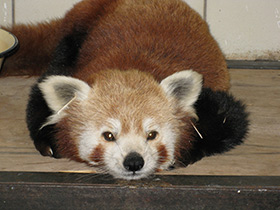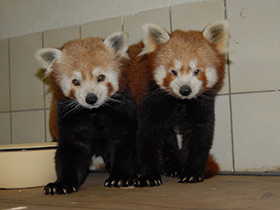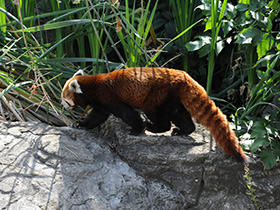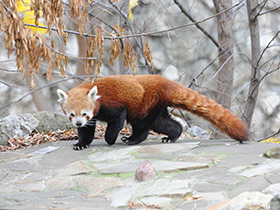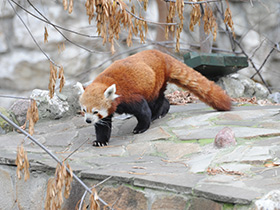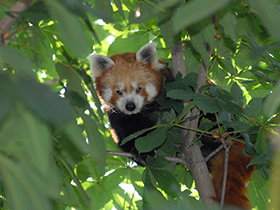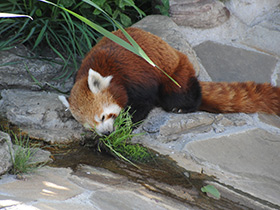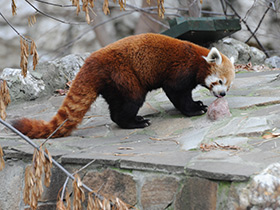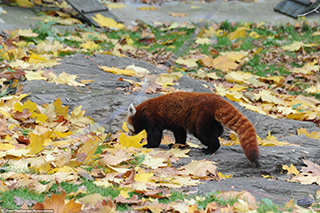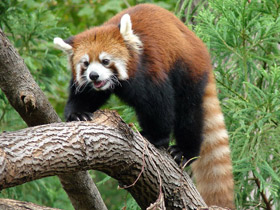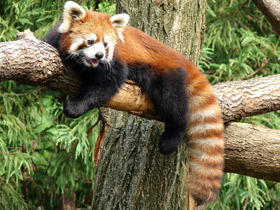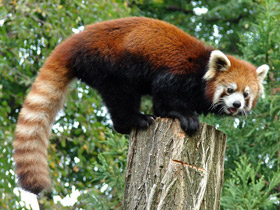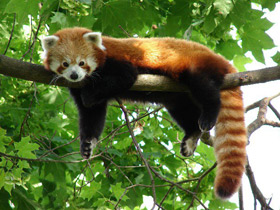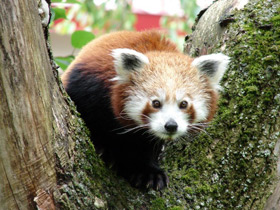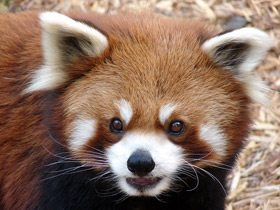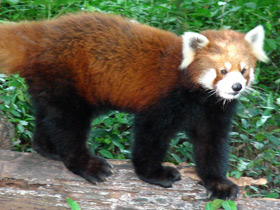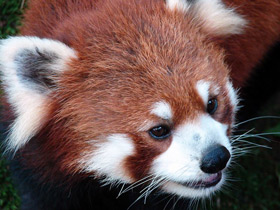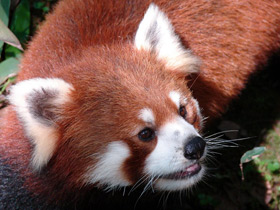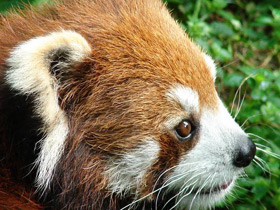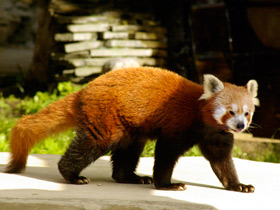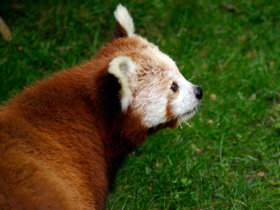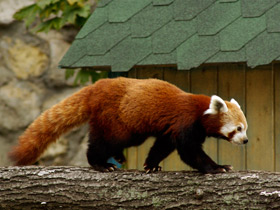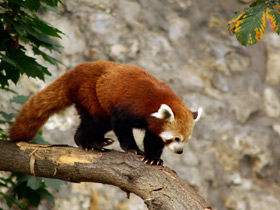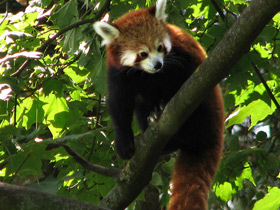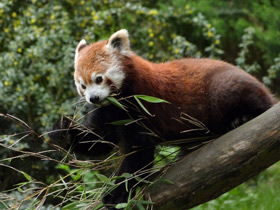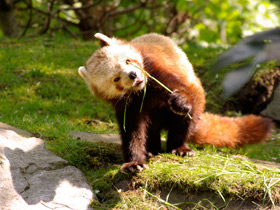The red panda or the lesser panda (Ailurus fulgens)
The red panda (Ailurus fulgens), also known as the lesser panda, is a small mammal native to the eastern Himalayas and southwestern China.
Etymology
The origin of the name panda is uncertain, but one of the most likely theories is that it derived from the Nepali word "ponya". The word पञ्जा pajā or पौँजा pañjā means "ball of the foot" and "claws". The Nepali words "nigalya ponya" has been translated as "bamboo footed" and is thought to be the red panda's Nepali name; in English, it was simply called panda, and was the only animal known under this name for more than 40 years; it became known as the red panda or lesser panda to distinguish it from the giant panda, which was formally described and named in 1869.
The genus name Ailurus is adopted from the Ancient Greek word αἴλουρος ailouros meaning 'cat'. The specific epithet fulgens is Latin for 'shining, bright'.
Taxonomy
The red panda was described and named in 1825 by Frederic Cuvier, who gave it its current scientific name Ailurus fulgens. Cuvier's description was based on zoological specimens, including skin, paws, jawbones and teeth "from the mountains north of India", as well as an account by Alfred Duvaucel. The red panda was described earlier by Thomas Hardwicke in 1821, but his paper was only published in 1827. In 1902, Oldfield Thomas described a skull of a male red panda specimen under the name Ailurus fulgens styani in honour of Frederick William Styan who had collected this specimen in Sichuan.
Subspecies and species
The modern red panda is the only recognised species in the genus Ailurus. It is traditionally divided into two subspecies: the Himalayan red panda (Ailurus fulgens fulgens) and the Chinese red panda (Ailurus fulgens styani). The Himalayan subspecies has a straighter profile, a lighter coloured forehead and ochre-tipped hairs on the lower back and rump. The Chinese subspecies has a more curved forehead and sloping snout, a darker coat with a less white face and more contrast between the tail rings.
In 2020, results of a genetic analysis of red panda samples showed that the red panda populations in the Himalayas and China were separated about 250,000 years ago. The researchers suggested that the two subspecies should be treated as distinct species. Red pandas in southeastern Tibet and northern Myanmar were found to be part of styani, while those of southern Tibet were of fulgens in the strict sense. DNA sequencing of 132 red panda faecal samples collected in Northeast India and China also showed two distinct clusters indicating that the Siang River constitutes the boundary between the Himalayan and Chinese red pandas. They probably diverged due to glaciation events on the southern Tibetan Plateau in the Pleistocene.
Description
In China, Ailurus fulgens is called hunho (firefox) because of the colour of its coat and its resemblance in size to a fox. The word is certainly familiar to all Internet users, as it was used by Mozilla to name its browser "MozillaFirefox". A modern, poetic and incredibly appropriate name for the small panda "shining, bright cat" was suggested by the French naturalist and scientist F.Cuvier.
Ailurus fulgens is not a large animal, its body length is about 60 cm, weight not more than 6 kg. The body of the panda is elongated, its fluffy tail is 28 to 48 cm long (different for different individuals), its head is broad, its ears are small and rounded, and its eyes are also small. Because of its convex forehead, its head acquires proportions peculiar to cubs and giving the animal an extraordinary cuteness (photo 1, 2). Near the eyes of this animal there is a mask-like pattern, the outline of which is unique for each individual (photo 3). Short, strong paws with semi-retractile claws allow the red panda to easily climb up and down trees. This cute animal has an "extra toe" on its wrist - an enlarged part of one of the bones of the foreleg. It is opposed to the other fingers and allows the panda to hold bamboo branches in its paws.
Lifestyle and diet
Ailurus fulgens are active mainly in the dark, but during the day they often sleep in trees, curled up and covering their heads with their tails like a blanket. These animals are slow and awkward on the ground, but they are excellent tree climbers; however, they feed mainly on the ground (photos 5 and 6, 7).
Behaviour and ecology
The red panda is difficult to observe in the wild, and most studies on its behaviour have taken place in captivity. The red panda appears to be both nocturnal and crepuscular, sleeping in between periods of activity at night. It typically rests or sleeps in trees or other elevated spaces, stretched out prone on a branch with legs dangling when it is hot, and curled up with its hindlimb over the face when it is cold. It is adapted for climbing and descends to the ground head-first with the hindfeet holding on to the middle of the tree trunk. It moves quickly on the ground by trotting or bounding.
Social spacing
Adult pandas are generally solitary and territorial. Individuals mark their home range or territorial boundaries with urine, faeces and secretions from the anal and surrounding glands. Scent-marking is usually done on the ground, with males marking more often and for longer periods. In China's Wolong National Nature Reserve, the home range of a radio-collared female was 0.94 km2 (0.36 sq mi), while that of a male was 1.11 km2 (0.43 sq mi). A one-year-long monitoring study of ten red pandas in eastern Nepal showed that the four males had median home ranges of 1.73 km2 (0.67 sq mi) and the six females of 0.94 km2 (0.36 sq mi) within a forest cover of at least 19.2 ha (47 acres). The females travelled 419–841 m (1,375–2,759 ft) per day and the males 660–1,473 m (2,165–4,833 ft). In the mating season from January to March, adults travelled a mean of 795 m (2,608 ft) and subadults a mean of 861 m (2,825 ft). They all had larger home ranges in areas with low forest cover and reduced their activity in areas that were disturbed by people, livestock and dogs.
Diet and feeding
The red panda is largely herbivorous and feeds primarily on bamboo, mainly the genera Phyllostachys, Sinarundinaria, Thamnocalamus and Chimonobambusa. It also feeds on fruits, blossoms, acorns, eggs, birds and small mammals. Bamboo leaves may be the most abundant food item year-round and the only food they can access during winter. In Wolong National Nature Reserve, leaves of the bamboo species Bashania fangiana were found in nearly 94 per cent of analysed droppings, and its shoots were found in 59 per cent of the droppings found in June.
The diet of red pandas monitored at three sites in Singalila National Park for two years consisted of 40–83 per cent Yushania maling and 51–91.2 per cent Thamnocalamus spathiflorus bamboos supplemented by bamboo shoots, Actinidia strigosa fruits and seasonal berries. In this national park, red panda droppings also contained remains of silky rose and bramble fruit species in the summer season, Actinidia callosa in the post-monsoon season, and Merrilliopanax alpinus, the whitebeam species Sorbus cuspidata and tree rhododendron in both seasons. Droppings were found with 23 plant species including the stone oak species Lithocarpus pachyphyllus, Campbell's magnolia, the chinquapin species Castanopsis tribuloides, Himalayan birch, Litsea sericea and the holly species Ilex fragilis. In Nepal's Rara National Park, Thamnocalamus was found in all the droppings sampled, both before and after the monsoon. Its summer diet in Dhorpatan Hunting Reserve also includes some lichens and barberries. In Bhutan's Jigme Dorji National Park, red panda faeces found in the fruiting season contained seeds of Himalayan ivy.
The red panda grabs food with one of its front paws and usually eats sitting down or standing. When foraging for bamboo, it grabs the plant by the stem and pulls it down towards its jaws. It bites the leaves with the side of the cheek teeth and then shears, chews and swallows. Smaller food like blossoms, berries and small leaves are eaten differently, being clipped by the incisors. Having the gastrointestinal tract of a carnivore, the red panda cannot properly digest bamboo, which passes through its gut in two to four hours. Hence, it must consume large amounts of the most nutritious plant matter. It eats over 1.5 kg (3 lb 5 oz) of fresh leaves or 4 kg (9 lb) of fresh shoots in a day with crude proteins and fats being the most easily digested. Digestion is highest in summer and fall but lowest in winter, and is easier for shoots than leaves. The red panda's metabolic rate is comparable to other mammals of its size, despite its poor diet. The red panda digests almost a third of dry matter, which is more efficient than the giant panda digesting 17 per cent. Microbes in the gut may aid in its processing of bamboo; the microbiota community in the red panda is less diverse than in other mammals.
Communication
At least seven different vocalisations have been recorded from the red panda, comprising growls, barks, squeals, hoots, bleats, grunts and twitters. Growling, barking, grunting and squealing are produced during fights and aggressive chasing. Hooting is made in response to being approached by another individual. Bleating is associated with scent-marking and sniffing. Males may bleat during mating, while females twitter.During both play fighting and aggressive fighting, individuals curve their backs and tails while slowly moving their heads up and down. They then turn their heads while jaw-clapping, move their heads laterally and lift a forepaw to strike. They stand on their hind legs, raise the forelimbs above the head and then pounce. Two red pandas may "stare" at each other from a distance.
Breeding
Ailurus fulgens live singly, each individual has its own territory and marks it with special secretion from anal glands, urine or piles of droppings (photo 9). In a nest of twigs and leaves the female gives birth to 1-2 blind and deaf cubs weighing about 100g. They are born only 90-145 days after mating, but the "real" pregnancy lasts only about 50 days. The fact is that the foetus begins to develop only after a fairly long period of time after conception (the so-called latent stage of pregnancy). The cubs grow very slowly: their eyes open only on the 18th day, and at the age of three months their grey fur acquires the red colour characteristic of adults, they begin to leave the nest and eat solid food. Young pandas roam with their mother around her property until mid-winter (and possibly for a whole year).
Mortality and diseases
The red panda's lifespan in captivity reaches 14 years. They have been recorded falling prey to leopards in the wild. Faecal samples of red panda collected in Nepal contained parasitic protozoa, amoebozoans, roundworms, trematodes and tapeworms. Roundworms, tapeworms and coccidia were also found in red panda scat collected in Rara and Langtang National Parks. Fourteen red pandas at the Knoxville Zoo suffered from severe ringworm, so the tails of two were amputated. Chagas disease was reported as the cause of death of a red panda kept in a Kansas zoo. Amdoparvovirus was detected in the scat of six red pandas in the Sacramento Zoo. Eight captive red pandas in a Chinese zoo suffered from shortness of breath and fever shortly before they died of pneumonia; autopsy revealed that they had antibodies to the protozoans Toxoplasma gondii and Sarcocystis species indicating that they were intermediate hosts. A captive red panda in the Chengdu Research Base of Giant Panda Breeding died of unknown reasons; an autopsy showed that its kidneys, liver and lungs were damaged by a bacterial infection caused by Escherichia coli.
Threats
The red panda is primarily threatened by the destruction and fragmentation of its habitat, the causes of which include increasing human population, deforestation, the unlawful taking of non-wood forest material and disturbances by herders and livestock. Trampling by livestock inhibits bamboo growth, and clearcutting decreases the ability of some bamboo species to regenerate.
Conservation
The red panda is listed in CITES Appendix I and protected in all range countries; hunting is illegal. It has been listed as Endangered on the IUCN Red List since 2008 because the global population is estimated at 10,000 individuals, with a decreasing population trend. A large extent of its habitat is part of protected areas.
Subspecies
- Ailurus fulgens fulgens;
- Ailurus fulgens styani.


















